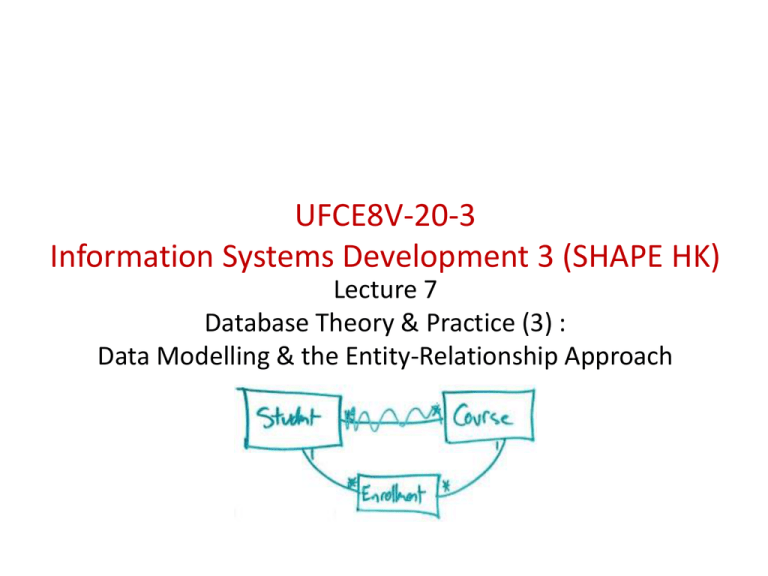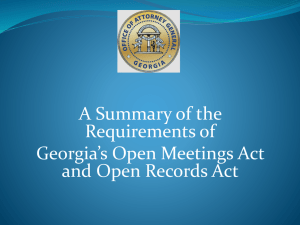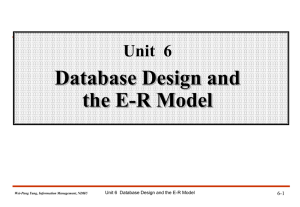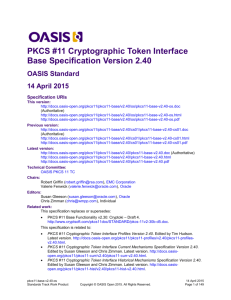
UFCE8V-20-3
Information Systems Development 3 (SHAPE HK)
Lecture 7
Database Theory & Practice (3) :
Data Modelling & the Entity-Relationship Approach
E-R modelling concepts (1)
o Entity & Attribute
An entity is anything relevant to the Universe of Discourse
(UoD) or domain. It can be defined as a group of logically
associated data items identified by a unique key. ‘Entity type’
is used to describe all entities relevant to the domain which
fit a given definition.
Entity type
Entity occurrence
Person
David Beckham, Miss Dynamite
Building
Buckingham Palace, Mansion House
Car
X723 LSO, S234 TJH
E-R modelling concepts (2)
o Identifying entities
This can be a difficult task. The analyst must gain a thorough
understanding of the system environment. The entities could come
to light, for example, from the dataflow diagrams produced during
systems investigation. Another method is to find the things in the
environment which need to be individually identified and referred
to. Notional keys can be used to identify a range of other data - for
example, a customer number identifies customer name and
address, class, credit limit etc., which leads us to identify the
CUSTOMER entity. Examples of notional keys could include:
– Customer number
– Product code
– Job number
– Account number.
E-R modelling concepts (3)
o Attributes
An attribute is a property or characteristic of an entity about which
there is a need to record data; it is the named column of a relation.
The attribute type is the collection of all values of a defined property
associated with a given entity type.
Entity
type
Attribute type
Attribute occurrence
Person
name
D. 0. B.
sex
John Smith
28.07.60
male
Building
address
annual rent
6 High Road
f90 per sq. metre
Note: there is no absolute distinction between entity type and attribute
type - an attribute type in one context can be an entity type in another. For
example, to a car manufacturer, COLOUR is an attribute of the entity type
CAR; to a paint manufacturer, COLOUR may well be an entity type.
E-R modelling concepts (4)
o Null values
A special value called the null value may be created when there is
no value for an attribute. Null can be used for one of two reasons:
either an entry is not applicable or it is not known.
- An example of 'not applicable' would be the attribute Flat Number
of an Address: this applies only to those people who live in flats;
the Flat Number attribute would be null for those people who live
in houses
- An example of 'not known' would be the Height attribute of a
Person being recorded as null if the height is unknown.
When a table is implemented (using SQL), nulls are treated in a
special way - as nulls rather than 'spaces' or zero. They are either
displayed empty, or, if part of a calculated column, the whole record
is excluded from the query, since it is not possible to determine the
result of a calculation with null.
E-R modelling concepts (5)
o Relationships
A relationship is an association between entities that is
operationally significant to the domain.
Entity
Relationship
Entity
At University of the West of England
STUDENTS
SCHOOLS
take
have
COURSES
STAFF
At Ford Motor Corporation
ASSEMBLIES
STAFF
have
work on
PARTS
CONTRACTS
E-R modelling concepts (6)
o The entity-relationship (E-R) diagram (an example)
Entities and relationships can be used to produce a
pictorial representation of the UoD. This picture is called
an entity-relationship diagram. The figure on the next
slide shows an entity-relationship diagram for the
following scenario:
“A University Library keeps information on books held,
students who borrow these books and the loans which the
students make. In addition, information is held about the
authors and publishers of these books. A database
designer has established the entities and attributes
needed to carry out typical library functions and has
produced the following entity-relationship diagram.”
E-R modelling concepts (7)
An University Library System E-R diagram (using UML):
E-R modelling concepts (9)
Notes on the diagram:
o Note that the Book-Copy table holds information on the physical books stored
in the library whereas the Book-Title table holds information on a particular
publication of a book.
o a book which is still out on loan will have a blank date-back field in the loan
table
o As copies of books become old, damaged and dirty, the books are removed
from the library and destroyed. Destroyed book copies have a date to indicate
this, otherwise the date is null.
o The diagram also shows the maximum and minimum times that an entity
occurrence can exist in a relationship. For example, a student can borrow zero
or more books. This is called an optional relationship: occurrences of an entity
(student) can exist independently of the loan entity. Otherwise, the relationship
is mandatory: every occurrence of an entity participates in the relationship. In
the book-title/authorship relationship, a title cannot exist without at least one
author. The notation used will be explained more fully in the next section. An ER diagram is drawn because:
- By analysing the entities and relationships of an UoD, many hundreds of
entities may be identified. The data model provides a concise summary of the
results of the analysis
- The E-R diagram will be used as the basis of database design. The structure
of the model will be mapped onto the logical structure of the database.
E-R modelling concepts (8)
E-R Diagramming Notation
o Note that, traditionally, entity names are in the singular form
o Rectangles are used to denote entity types (named normally as a noun)
and lines represent relationship types
o The lines are labelled with the names of the relationship (normally as a
verb)
o The arrow symbol indicates the correct direction for the name of the
relationship to make sense. For example, a student makes many loan
records.
o The diagram (on the previous slide) uses a notation based on the unified
modelling language (UML) for the entity-relationship diagram – there are
a number of other notations also used (e.g. Chen, “crows-feet” notation).
E-R modelling concepts (10)
Example - An E-R diagram of a Chess League (using the OMT notation):
E-R modelling concepts (10)
Example - An E-R diagram using Chen’s notation:
E-R modelling concepts (10)
Example - An E-R diagram using Crow’s Feet notation:
E-R modelling concepts (11)
o The cardinality of a relationship
There are several relationship types:
– One-to-one relationships
– One-to-many relationships
– Many-to-many relationships
– Recursive (or involute) relationships
E-R modelling concepts (12)
o One-to-one relationship
In a 1-to-1 relationship, an occurrence of the first entity type is
related to a maximum of one occurrence of the second entity type,
and each occurrence of the second type to a maximum of one of the
first.
One member of parliament is elected to one constituency; one
constituency has one MP elected to it.
E-R modelling concepts (13)
o One-to-many relationship
In a 1-to-m relationship, an occurrence of the first entity type may be
related to several occurrences of the second, but each occurrence of
the second is related to a maximum of one occurrence of the first.
One customer places zero or more orders; one order is placed by one
customer.
E-R modelling concepts (14)
o Many-to-many relationship
In a m-to-m relationship, an occurrence of the first entity type may be
related to several occurrences of the second and vice versa.
One depot holds zero or more products; one product is held at one or
more depots.
E-R modelling concepts (15)
o Recursive (or involute) relationship
In a recursive relationship, entity occurrences relate to other
occurrences of the same entity.
One employee (a manager) manages one to twenty employees; one employee is
managed by one employee (manager).
E-R modelling concepts (16)
o Decomposition
All many-to-many relationships, can be decomposed into two one-tomany relationships. One reason for doing this is that relational DBMSs
do not support many-to-many relationships directly. Also, by
eliminating many-to-many relationships, problems in the model
become easier to spot.
E-R modelling concepts (17)
o Key attributes
It may be necessary to specify one or more of the attributes of an entity as
a 'key' of the entity. This is particularly true of the relational model. Three
types of keys are defined here:
– A candidate key is a unique identifier for the entity - there may be
more than one candidate key (for example, customer-no, customer
address)
– A primary key (PK) is also a unique identifier for the entity - that is, an
attribute (or combination of attributes) with the property that, at any
given time, no two entity occurrences contain the same values for that
attribute (or combination of attributes). One candidate key is chosen
as the primary key. (Between the two candidate keys mentioned
above it is likely that customer-no would be chosen as the primary key
as this is more likely to be unique.)
– A foreign key (FK) is an attribute in a relation which is also the primary
key in another relation (often) or a candidate key (sometimes).
Bibliography / Readings / Home based activities
Bibliography
-
An Introduction to Database Systems (8th ed.), C J Date, Addison Wesley 2004
Database Management Systems, P Ward & G Defoulas, Thomson 2006
Database Systems Concepts (4th ed.), A Silberschatz, H F Korth & S Sudarshan, McGraw-Hill
2002
Readings
-
Introduction to SQL McGraw-Hill/Osbourne (handout)
Home based activities
-
Copy the SQL Workbook onto your data key or CD.
Import the tables from the SQL Workbook into your home MySQL DB. Begin working through
some of the query examples in the workbook using PHPMyAdmin.












